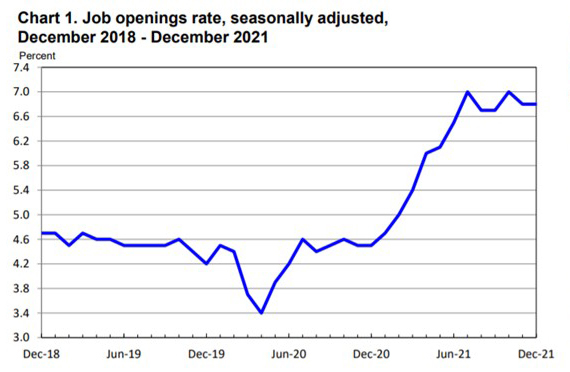
‘Great Resignation’ Shows No Signs of Slowing

Nearly 11 million jobs remained open and nearly 6 million more Americans left their jobs in December—signaling the “Great Resignation” shows no signs of stopping, the Bureau of Labor Statistics reported Tuesday.
The monthly BLS Job Openings and Labor Turnover Survey—known as “JOLTS”—reported December job openings were unchanged from November at 10.9 million—nearly 1.73 job openings for every unemployed worker. Hires and total separations decreased to 6.3 million and 5.9 million, respectively. Within separations, the quits rate was little changed at 2.9 percent. The layoffs and discharges rate was little changed at 0.8 percent, a series low.

BLS reported the job openings rate was unchanged at 6.8 percent. Job openings increased in several industries, with the largest increases in accommodation and food services (+133,000), information (+40,000) and nondurable goods manufacturing and state and local government education (+31,000 each).
Employers continued to have problems filling positions. In December, the number of hires decreased to 6.3 million (-333,000), while the hires rate was little changed at 4.2 percent.
And while total separations decreased to 5.9 million (-305,000), the total separations rate was little changed at 4.0 percent. Quits edged down in December to 4.3 million (-161,000) following a series high in November. The quits rate was little changed at 2.9 percent. Meanwhile, the number and rate of layoffs and discharges were little changed at 1.2 million and 0.8 percent, respectively; both series lows.
For the 12 months ending in December, hires totaled 75.3 million; separations totaled 68.9 million, yielding a net employment gain of 6.4 million. These totals include workers who may have been hired and separated more than once during the year.
“Still-solid demand for workers at the end of the year, as evidenced by job openings rebounding to 10.9 million in December, supports our expectation that the weakness in the January employment report should prove temporary,” said Sarah House, Senior Economist with Wells Fargo Economics, Charlotte, N.C. “Workers continue to hold significant sway over employers, with the quit rate hovering near a record high.”
House noted despite a softer hiring picture toward the end of the year, demand for workers remained solid. “With employers so keen to hire, the hit to payrolls in January from Omicron that is keeping scores of workers at home should be short-lived,” she said. “There are now 1.73 job openings for every unemployed worker compared to a peak of 1.40 the past cycle, one of the many signs of the tight labor market.”
House added the scramble to retain workers is helping to push the probability of strong wage growth continuing to a 50-year high. “While it is a challenge to businesses, the significant resorting could yield productivity benefits to the boarder economy down the road as employees find opportunities in positions better suited to their skills and interests,” she said. “A significant shift remains, underscoring that industry changes, health and childcare considerations and the policy landscape of the past 22 months have made for a very different labor market today.”
